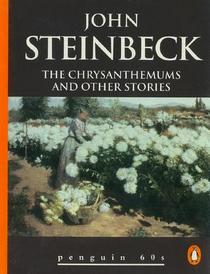"The Chrysanthemums" by John Steinbeck
Read "The Chrysanthemums" here
Steinbeck was interested in the author D.H. Lawrence, and wrote "The Chrysanthemums" in the same vein as Lawrence's short story "Odour of the Chrysanthemums". Both stories deal with sexuality and balancing needs and self-interest (Charters, pg.222). The chrysanthemum flowers symbolize Elisa's "femininity and sexuality" and represent her caring nature (Kassim, 2021). The flowers become a stand-in for the children she wishes she could have someday. Elisa feels that she is in a romantic-less relationship with Henry and doesn't appreciate her female attributes.
While Steinbeck has written female characters as flat and with a sexist point of view, this story surprises the audience with a strong female protagonist. "Steinbeck's sympathy and understanding for women are almost shockingly modern" (Sparknotes.com). Elisa is allowed to thrive in her garden, but he gives her a positive sexual desire not usually seen in works when the story was written. Unlike his other female characters, Elisa is not pregnant, nor does she and Henry have kids.
During her encounter with the stranger or tinker, Elisa is attracted to him after he compliments her chrysanthemums. His appreciation of her hard work leads to a flirtatious conversation ending with Elisa hopeful that her life can change. She takes a bath to get ready for her night out with Henry. "Elisa sheds her old self by scrubbing and brings new life and change" (Kassim, 2021). She admires her body in the mirror before putting on a dress and makeup, hoping that this change will spark something in her marriage. However, Henry's compliments are less than flattering, and Elisa realized that her marriage would never be more excited. The best she can hope for is some wine with dinner.
In this story, Steinbeck's usual theme of the "American dream" is present in Elisa's longing to have children and be appreciated as a woman rather than a worker. One of the things that I enjoyed about this story was that it featured a strong woman with needs and desires. However, in the end, her passions are not met. Even though it was written in 1938, the story has a more modern feel, highlighting the life of a strong woman, even though she is still being held back. I thoroughly enjoyed reading this story. If you've read it, please leave your comments below, and let me know your thoughts on author John Steinbeck. Two more works left to review, so keep checking back and make sure to follow on Twitter for updates!
Works Cited
Sparknotes.com, 2021. https://www.sparknotes.com/short-stories/the-chrysanthemums/section1/, https://www.sparknotes.com/short-stories/the-chrysanthemums/themes/
Lone Star College, 2021. “Symbolism in The Chrysanthemums” by Elizabeth Kassim. https://www.lonestar.edu/symbolism-chrysanthemums.htm
"Part Two: Commentaries." The Story and Its Writer: An Introduction to Short Fiction, by Ann Charters, 9th edition. Bedford/St. Martins, 2015.




No comments:
Post a Comment